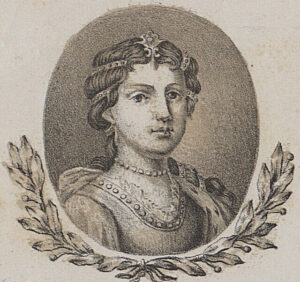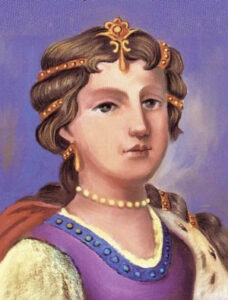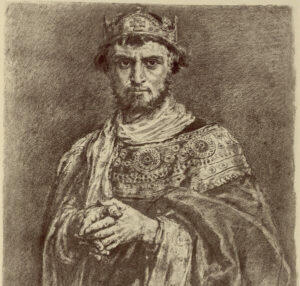Her origins are shrouded in mystery, which continues to ignite historians’ imagination. Was she the daughter of the powerful Yaroslav the Wise, ruler of Kievan Rus, as some sources suggest? Or perhaps she was born much earlier, which would indicate a completely different lineage? Who was Dobroniega Maria, the wife of Casimir the Restorer, really?
Prince Casimir the Restorer
Casimir the Restorer was the son of Mieszko II Lambert and Richeza, daughter of the Palatine of Lotharingia and niece of Emperor Otto III. He was born on July 25, 1016, probably in Cracow, where he spent his early childhood. He received his education in a monastery, which allowed the chronicler Gallus Anonymus to call him „an eloquent man” and „an educated person”.
Casimir’s life coincided with a difficult period for the Piast state. In 1031, he had to leave Poland when Prince Bezprym seized power. After his father’s death (1034), he returned to the country, where he was initially supported by nobles and his mother. Eventually, however, the magnates expelled both Richeza and her son. Casimir was taken to Hungary, where he was imprisoned by King Stephen the Great. After Stephen’s death in 1038, his successor allowed him to leave the country.
During this time, Poland was invaded by the Czech Prince Bretislav, who ravaged the Piast lands and annexed Silesia to Bohemia. Simultaneously, in Mazovia, Mieszko II’s former cupbearer, Miecław, built a rival state encompassing Mazovia, Kuyavia, Chełmno Land, and part of Greater Poland.
Casimir returned to Poland with German military support (500 armed men), which allowed him to begin reclaiming his heritage. First, he captured one of the unknown strongholds, and then extended his power to Greater Poland and Lesser Poland. He chose Cracow as his permanent residence, which became the capital of the restored state. This decision was due to the intact state of the stronghold’s fortifications, its strategic location on trade routes, and proximity to Bohemia. The connection between Cracow and Kiev was also significant, facilitating communication with the Rurikids, with whom Casimir established close relations.
The exact date of Casimir the Restorer’s return to Poland is not known. Some scholars believed that Mieszko II’s son appeared in Poland as early as 1038. However, J. Bieniak was of a different opinion, dating the Piast’s return to 1041. His opinion conflicts with the account of Gallus Anonymus, according to whom Casimir stayed abroad for „a short time.” This phrase does not necessarily mean that the prince came to Poland in 1038, as Bretislav’s expedition against the Piast state took place during an interregnum, which was noted in contemporary written sources.

Where did Dobroniega come from?
The date of Casimir’s return to his homeland is closely related to the prince’s marriage to the Ruthenian princess Dobroniega. Her second name was Maria. Forms of both these names were given in sources such as: The Cracow Chapter Annals, Lesser Poland Annals, Polish-Silesian Chronicle, the so-called Breve of Benedict IX, Płock Genealogy, Greater Poland Chronicle, and Holy Cross Annals. The appearance of the name Maria in what turned out to be a forged document of Benedict IX authenticates its sound. The author of the forgery was well-informed about the princely couple’s names. He knew that Casimir’s second name, already attested by Gallus Anonymus, was Charles. Under these circumstances, Dobroniega’s second name cannot be questioned.
In light of one of the later chronicles, Dobroniega’s real name was Dobrawa. The same name was borne by Casimir the Restorer’s great-grandmother, the first wife of Mieszko I, through whom Christianity came to Poland. In the literature on the subject, it was suggested that Casimir deliberately gave his wife a new name because he strongly believed that she would become his true helper, like his great-grandmother Dobrawa, who was a pillar of Mieszko’s reign. Whether this was actually the case is difficult to determine conclusively at present. This theory is rather unlikely, as none of the sources contemporary to Casimir mention a change of his wife’s name to another.

The issue of Dobroniega’s origin is problematic. According to Gallus Anonymus, Casimir the Restorer’s chosen one came from a noble family. This enigmatic mention by the oldest Polish chronicler was supplemented by the Tale of Bygone Years, written at the beginning of the 12th century, which mentioned that Casimir’s wife was the sister of the Grand Prince of Kiev, Yaroslav the Wise.
Most scholars to date have agreed with the Old Ruthenian source, with only a few recognizing Dobroniega not as the daughter of Vladimir the Great (Yaroslav the Wise’s father), but as the daughter of Yaroslav himself. This latter suggestion refers to information found in the chronicle of the so-called Annalista Saxo. It follows from this that after returning to Poland, Casimir married the daughter of the then Ruthenian prince, that is, Yaroslav the Wise. However, this note may be erroneous, especially since the chronicler was decidedly better informed about Ruthenian affairs than Annalista Saxo, who wrote his work devoted mainly to the history of Germany until 1139 in the Nienburg monastery on the Saale.
See also: Marina Mniszech. How a Polish Woman Became Tsarina of Russia
Sister of Yaroslav the Wise?
The information contained in the Tale of Bygone Years was once questioned by A. Brückner, who claimed that if Dobroniega were Yaroslav the Wise’s sister, she would have been about thirty years older than Casimir the Restorer. The scholar, assuming that Vladimir the Great’s last wife, the Byzantine princess Anna Porphyrogenita, was infertile, concluded that Dobroniega might have been born before 989. S. Kętrzyński, one of Casimir the Restorer’s biographers, fully agreed with Brückner’s opinion, adding that at the time of the Polish prince’s marriage to the Ruthenian woman, Yaroslav already had daughters of marriageable age.
Doubts about the information in the Tale of Bygone Years were also expressed by J. Wagilewicz and L. Ćwikliński, who favored the opinion contained in the late medieval Greater Poland Chronicle, according to which Dobroniega was the daughter of Roman, son of Odo. Based on this brief mention, Dobroniega began to be identified as the granddaughter of Bezprym-Otto, the eldest son of Bolesław the Brave. According to S. Kętrzyński, Roman was actually Dobroniega’s grandfather and simultaneously a Byzantine emperor, the father of Anna, Dobroniega’s mother. Meanwhile, the Russian historian W. Torop believed that Dobroniega was the daughter of Boris Vladimirovich (bearing the Christian name Roman) and Świętosława, Bolesław’s daughter (sister of Bezprym-Otto).
In the most recent historiography, the information contained in the Greater Polish chronicler’s work is considered fabricated, so hypotheses based on it should not arouse much confidence. Following K. Jasiński, one of the best experts on the genealogy of the first Piasts, it can be acknowledged that Dobroniega Maria was indeed – as written in the Tale of Bygone Years – the sister of Yaroslav the Wise.
This remark would agree with the results of J. Bieniak’s research, who considered the mentioned account to be credible. It should be noted that nothing concrete is known about the infertility of Anna, Vladimir the Great’s last wife confirmed in the sources. What is certain, however, is that she did not bear male offspring to the Rurikid. She could, however, have given birth to daughters, about whom the chroniclers did not mention much.
See also: Wife of Mieszko the Old – the Mysterious Princess
Alternatively, Dobroniega might have come from Vladimir’s relationship with an unnamed woman who survived him. Her existence was confirmed by the contemporary Merseburg Bishop Thietmar (975-1018), according to whom Vladimir the Great, who died in 1015, left behind a widow. Historians highly value the account of the Saxon clergyman, who in many cases derived his knowledge from autopsy, which authenticates the version of events proposed here. There is, however, no basis to believe, as some genealogists wanted, that Dobroniega’s mother was the granddaughter of the German nobleman Kuno von Oehningen.

Princess from a monastery?
Experts on the subject believe that Dobroniega Maria was born no later than 1016, assuming that she appeared in the world after her father’s death and was his daughter from the last marriage with Yaroslav the Wise’s unnamed stepmother. It is also possible that the princess was born as early as 1010, which would mean she was six years older than Casimir the Restorer. Such an age difference (or significantly larger) was acceptable at that time, despite the fact that an unwritten rule had developed that the husband should be older than the wife, there were numerous exceptions in this regard.
Some historians believed that Dobroniega was in a monastery before her marriage, from which she was extracted after the possibility of her marriage to Casimir the Restorer arose. However, this revelation was not confirmed by any source. The possible stay of Yaroslav the Wise’s sister in a monastery would not have been practically any obstacle to her marrying the Polish prince.
See also: Anastasia – Wife of the Unfortunate Piast Prince
During the period in question, nuns repeatedly entered into marriages with laypeople, although this was met with condemnation from church dignitaries. An example here is Oda, Mieszko I’s second wife, a nun from St. Lawrence’s monastery in Kalbe. This marriage was contracted for purely political reasons, and after its finalization, a crowd of captives previously caught by the ruler of the Polans after one of the victorious wars with the western neighbor returned to Germany.
Bibliography:
-Bieniak J., Państwo Miecława. Studium analityczne, Warszawa 2010.
-Dróżdż K., Kazimierz Odnowiciel. Polska w okresie upadku i odbudowy, Wodzisław Śląski 2009.
-Gierlach B., Świt Mazowsza, Warszawa 1984.
-Gierlach B., Z problematyki państwa Miecława: zagadnienia polityczne, gospodarcze i militarne, „Rocznik Mazowiecki” 1976, t. 6.
-Grabski A.F., Powiest wremiennych let jako źródło do dziejów Polski w świetle nowszej literatury, „Kwartalnik Instytutu Polsko-Radzieckiego” 1955, nr 1–2.
-Grünberg K., Sprengel B., Trudne sąsiedztwo. Stosunki polsko-ukraińskie w X–XX wieku, Warszawa 2005.
-Jakowenko N., Historia Ukrainy do 1795 roku, przeł. A. Babiak-Owad, K. Kotyńska, Warszawa 2011.
-Jasiński K., Dobroniega Maria, [w:] Słownik starożytności słowiańskich, t. 8, Wrocław 1991.
-Jasiński K., Rodowód pierwszych Piastów, posł. T. Jurek, Poznań 2004.
-Jasiński T., Gall Anonim – poeta i mistrz prozy. Studia nad rytmiką prozy i poezji w okresie antycznym i średniowiecznym, Kraków 2016.
-Kętrzyński S., Kazimierz Odnowiciel (1034–1058), [w:] idem, Polska X–XI wieku, Warszawa 1961.
-Ksyk-Gąsiorowska P., Kazimierz I Odnowiciel, [w:] Piastowie. Leksykon biograficzny, red. S. Szczur, K. Ożóg, Kraków 1999.
-Kuczyński S.M., Nieznany traktat polsko-ruski roku 1039, „Slavia Antiqua” 1954–1956, t. 5.
-Łowmiański H., Dynastia Piastów we wczesnym średniowieczu, [w:] Początki państwa polskiego. Księga Tysiąclecia, t. 1, red. K. Tymieniecki, Poznań 1962.
-Pac G., Kobiety w dynastii Piastów. Rola społeczna piastowskich żon i córek do połowy XII wieku. Studium porównawcze, Toruń 2013.
-Russocki S., Region mazowiecki w Polsce średniowiecznej. Dotychczasowe ustalenia, nowe perspektywy i postulaty badawcze, „Przegląd Historyczny” 1963, t. 54, nr 3.
-Russocki S., Spory o średniowieczne Mazowsze, „Rocznik Mazowiecki” 1972, t. 4.
-Samp M., Kazimierz Odnowiciel. Roztropny polityk, zwycięski wódz, Warszawa 2021.
Author: Gabriela Zapolska